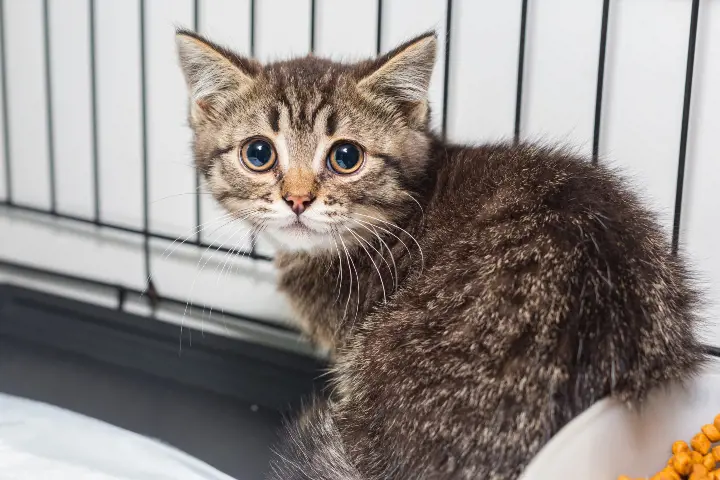Taming the wild: A comprehensive guide on how to tame a feral kitten
17th October, 2023

Bringing a feral kitten into your home can be a rewarding experience. These wild-born kittens can transform into loving and loyal companions with the right approach. Let's explore how to tame a feral kitten in a step-by-step process that ensures the welfare of the animal and their seamless integration into your home.
Understanding feral kittens
Feral kittens are wild-born kittens that have had little to no human contact, making them fearful and wary of people. Despite their initially wild nature, these kittens can be tamed and socialised, transitioning into wonderful domestic pets.
Quick tip: If you're considering adopting a feral kitten in the UK, ensure you’re familiar with the local wildlife and animal control regulations.
You can search "how to tame a feral kitten UK" for region-specific guidelines. You may also want to consider the steps you may need to take when you find a stray or feral kitten.
What is a feral kitten? Are they different from a stray kitty?
What is a feral kitten and a stray kitten, you ask? Well, these two terms may seem similar, but they describe two very different situations in the feline world.
A feral kitten is one that was born in the wild and has had little to no human contact. They are typically very wary of humans and often live in colonies with other feral cats. While they may share traits with domesticated cats, their lack of socialisation makes them wildly different.
On the other hand, a stray cat is one that has been abandoned or has gotten lost from its home. These kitties have had human interaction before, hence they are more likely to approach humans for tasty food or shelter.
Unlike their feral counterparts, stray kittens can often be reintegrated into a home with patience and care, given that they've had such experiences before.
Identifying the age of the kitten
The age of the kitten plays a crucial role in the taming process. Younger kittens, especially those under 6 weeks, can usually be tamed faster than older kittens.
The older the kittens are when first socialised, the longer it may take them to adjust. However, with patience and consistency, even older kittens can be domesticated.
How long does it take for a feral kitten to tame?
Taming a feral kitten is a rewarding experience that requires dedication, commitment, and lots of patience. The question buzzing in your mind might be "How long does it take for a feral kitten to tame?" and there isn't a definitive answer.
The duration it takes to tame a feral kitten largely depends on the individual kitten's personality, age, and prior experiences with humans. Generally, kittens under 8 weeks of age can often be socialised in about 2-4 weeks. Older cats might take longer, sometimes several months or more.
The process of taming involves gradually acclimating the kitten to human touch and presence, which takes time. They need to learn that humans are not a threat but a source of food, comfort, and care. It's important to approach this process slowly and gently, never forcing interaction but allowing the kitten to set the pace.
With consistent effort, the once wild kitten will start showing signs of trust like purring, seeking attention, and playing with lightweight cat toys. It's a slow journey filled with small victories that eventually lead to a fully socialised cat that is ready for a loving home.
Should you tame a feral kitten?
The question, "Should you tame a feral kitten?" is a complex one. On one hand, it's not uncommon to feel a sense of responsibility or compassion towards feral kittens.
These kittens are often wild animals and have little to no human interaction, making their lives significantly more challenging than those of domesticated cats.
Taming them could potentially give them a better quality of life and the opportunity for a loving home. However, it's important to remember that taming feral cats isn't as simple as bringing them inside and providing them with food and water. It requires time, patience, and a level of understanding about feline behaviour.
Feral kittens might initially respond with fear or aggression, and the process of taming kittens can be slow and difficult. Additionally, it's crucial to consider the potential health risks associated with feral cats, such as diseases or parasites, which could potentially be transmitted to other pets or humans in your household.
It's always recommended to consult with a veterinarian or an animal behaviourist before deciding to tame a feral kitten.
Preparing for the taming journey

Before you begin the taming process, there are a few things you need to prepare. Your kitten will need a secure, confined space, such as a cage or a small room.
Also, you'll need to have food, water, and a litter box at hand. Remember, kittens respond well to gentle care, so patience, time, and lots of parental love are essential.
The taming process: Step-by-step
Step 1: Initial confinement
Place the kitten in a cage or a small room with a litter box, food, and water. The cage should be mostly covered, helping the aggressive kitten feel safe.
Avoid handling the cat for the first few days, but make frequent visits to talk softly, display submissive behaviour and help them get used to your presence.
Step 2: Gentle handling
After a few days, you can start periodic and brief handling of the kitten. Always approach them slowly and calmly, avoiding any sudden movements.
Start by gently stroking the kitten while you speak softly with a reassuring tone. Over time, the kitten stays calm and will start to associate your touch and human voices with safety and comfort.
Step 3: Introducing treats
Food plays a vital role in the socialisation process. Offering treats regularly can help the kitten associate you with positive experiences. Initially, you might need to place the treat near the kitten. Gradually, hold the treat further away, encouraging the kitten to move towards you.
Step 4: Expanding their world
Once the kitten starts showing considerable progress and seems comfortable in its small confinement, you can gradually introduce them to a larger space. Always make sure the room is kitten-proof, with no potential hazards or escape routes.
Step 5: Socialising with other humans
When the kitten remains calm and stops responding with fear or aggression, it's time to introduce them to other people. Encourage family members and friends to handle the cat gently.
This socialisation phase is important for the timid kitten to get accustomed to different people and not just bond with one human.
Adopting and raising a feral kitten—what home is best for them?
Adopting and raising feral cats is a rewarding, albeit challenging endeavour. The key question that arises is "what home is best for them?"
An ideal home for feral kittens is one that provides a safe, nurturing, and patient environment. It's crucial to understand that feral kittens are not familiar with human interaction and will require time and patience to adjust to their new surroundings.
The best home would be one where the kitten can gradually learn about living indoors. A quiet and calm household, possibly without other pets or small children, could offer the perfect setting for a feral cat to adapt at its own pace.
The new owners should be willing to dedicate time to socialise the timid kitten, helping them learn to trust humans. It's important not to force interactions but instead allow the frightened kittens to approach on their own terms.
Lastly, as feral kittens are used to having a lot of space, a home where they have ample room to explore would be beneficial. Providing hiding spaces, toys for mental stimulation, and vertical spaces like cat trees can help them feel more comfortable.
Safety and other considerations when bringing home a feral cat
Bringing home a feral cat can be a rewarding experience, but it's not something to jump into without proper thought and preparation. Beyond the warm, fuzzy feelings, there are several safety and other considerations when bringing home a feral cat.
Feral cats are not socialised to humans, and they can be skittish, aggressive, or unpredictable. It's crucial to ensure your home environment is safe and suitable for them.
Consider your ability to provide long-term care for a feral cat. This includes regular vet checkups, vaccinations, and feeding.
Feral cats may also require more time and patience to become comfortable in a domestic setting. You may also need to 'cat-proof' your home by removing toxic plants, securing loose wires, and ensuring the cat can't escape.
You should also think about the other members of your household. If you have young children or other kittens, a feral cat may not be the best fit. The cat may have aggressive body language out of fear or dominance, leading to injuries or fights.
Make sure you have the cat tested for diseases before bringing it into your home. Feral cats can carry diseases like rabies, a flea infestation or feline AIDS which can spread to humans or other pets.
Remember, adopting a feral cat is a big responsibility and should not be taken lightly.
Post-taming: Welcoming your new family member
Once your kitten has become comfortable with you and their new surroundings, it's time to celebrate! You've successfully tamed a feral kitten. Now, it's all about nurturing this new bond and ensuring your kitten feels loved, secure, and happy in their new home.
Don't forget to consider getting a pet insurance quote to protect against the financial strain of unsuspected veterinary treatment whilst ensuring the well-being of your new furry friend.
You can get a quote through our website or get in touch with us on 0330 102 5748.
How do you bond with a stray kitten?
Building a bond with a stray kitten might not be as straightforward as it seems. Yet, it can be a rewarding experience that will melt your heart. So, how do you bond with a stray kitten?
- Approach the kitten calmly and gently, making sure not to frighten it. Keep in mind that trust is built over time. Therefore, patience is key in this process.
- Food is an excellent way to create a bond. Offer some cat-friendly food and water, but don't force it. Let the kitten approach on their own terms.
- Once the kitten begins to trust you, slowly start to engage in physical contact. Stroking and petting them gently will help build a strong emotional connection.
- As the kitten gets more comfortable with your presence, playtime can be a great bonding activity. Cat toys like balls, feathers or laser pointers can spark their interest and initiate playful interaction.
Remember to always give the kitten the space they need and never rush the process.
You should always make sure the kitten is healthy. Taking a visit to the vet can ensure that the kitten is disease-free and safe to bring into your home. This step not only helps protect you and your family but also shows the kitten that you care.
Conclusion: Patience is key

Taming a feral kitten requires patience, love, and consistency. While the process might seem challenging at first, remember that each small step brings you closer to a lifelong bond with a new, loving pet.
So, when you see a stray kitten and wonder, "how to tame a stray kitten," remember this guide and embark on a rewarding journey of transformation.
No matter where you live, whether you're searching "how to tame a feral kitten in the UK" or elsewhere, the principles remain the same. With time, patience, and lots of love, you can transform the life of a feral kitten, giving them a chance at a happy, safe, and comfortable life.
Helpful Pages
Recent Posts
Pet Insurance Quote
- 98% claims paid *
- Claims paid directly to vets
- 24/7 vet video consultations
- Interest free monthly payments




